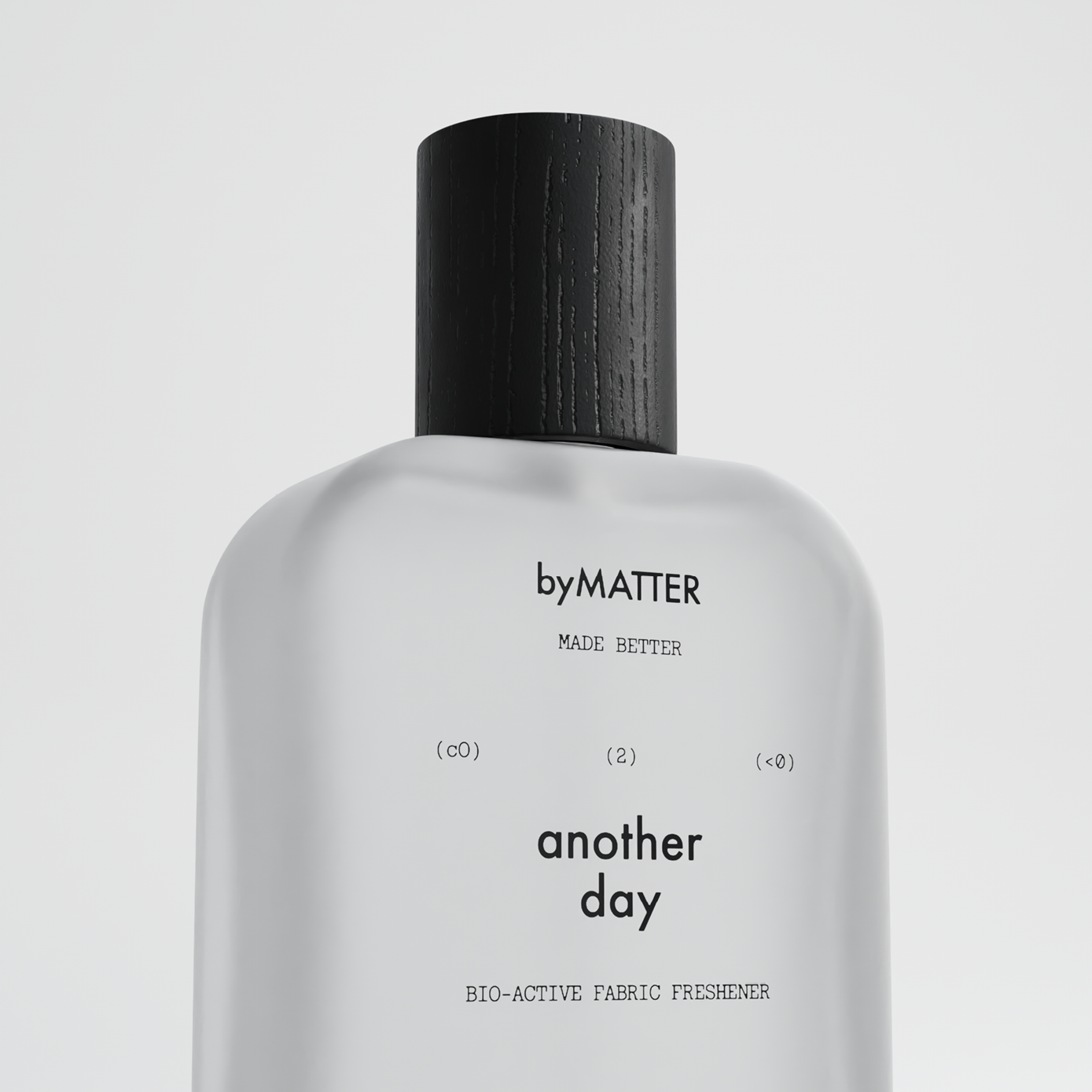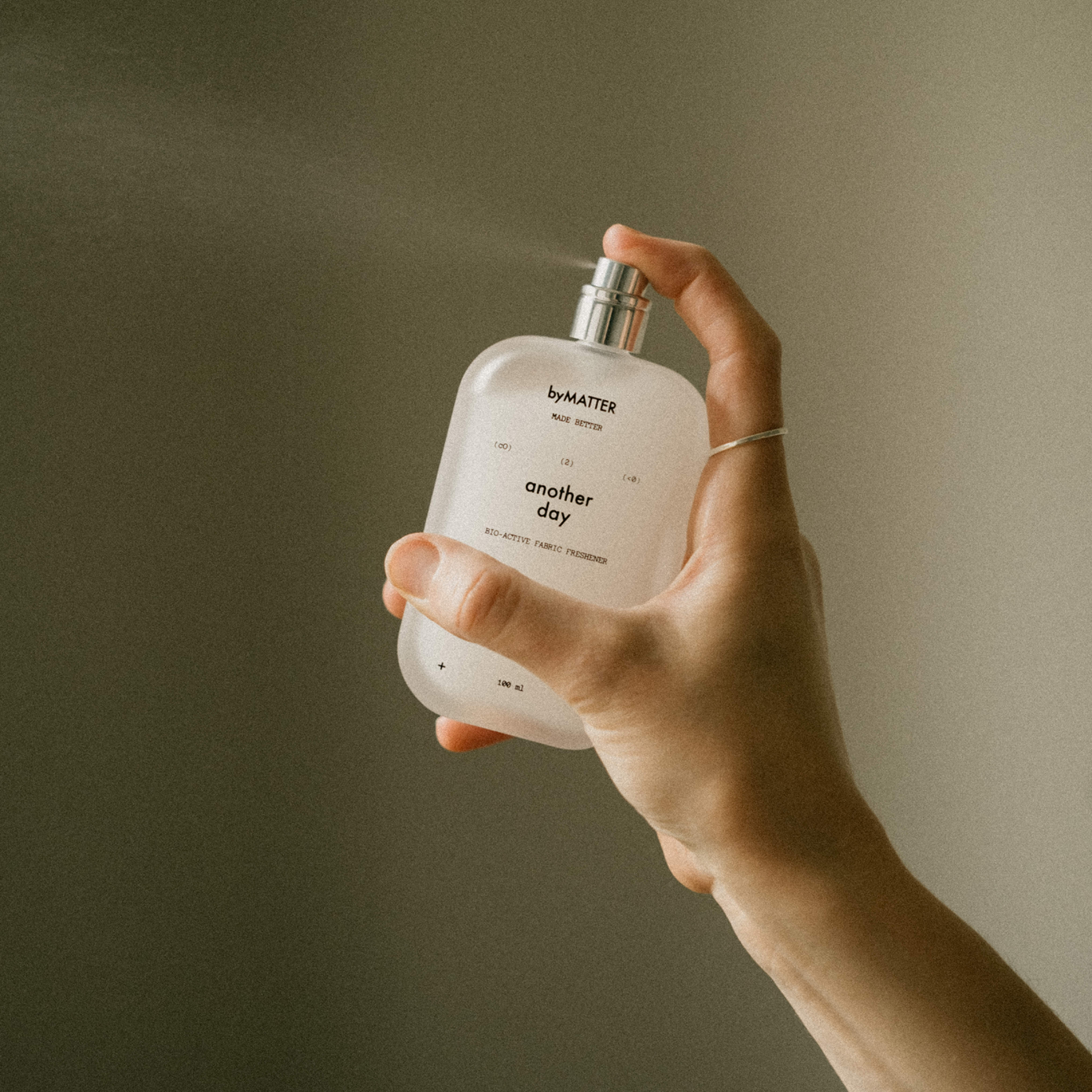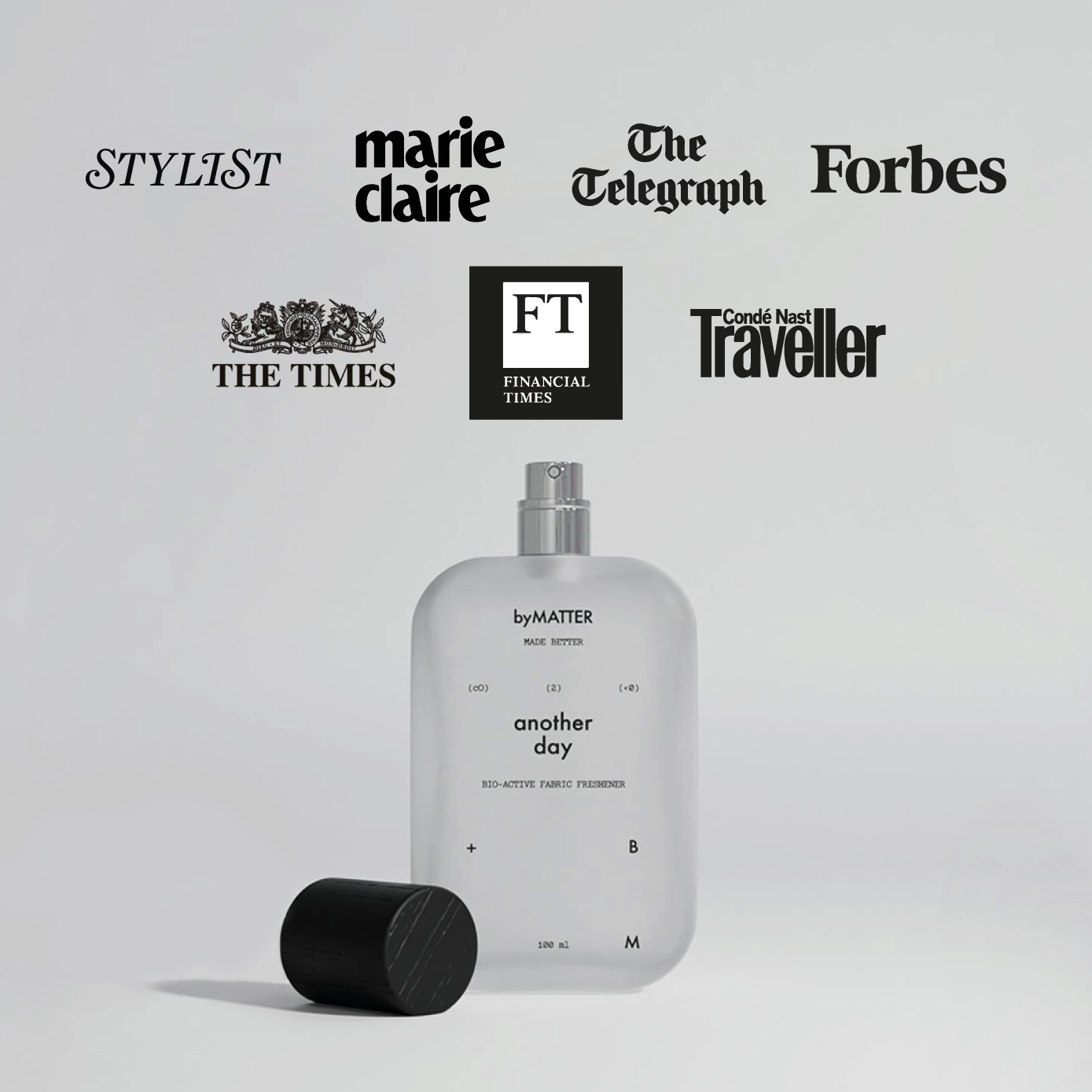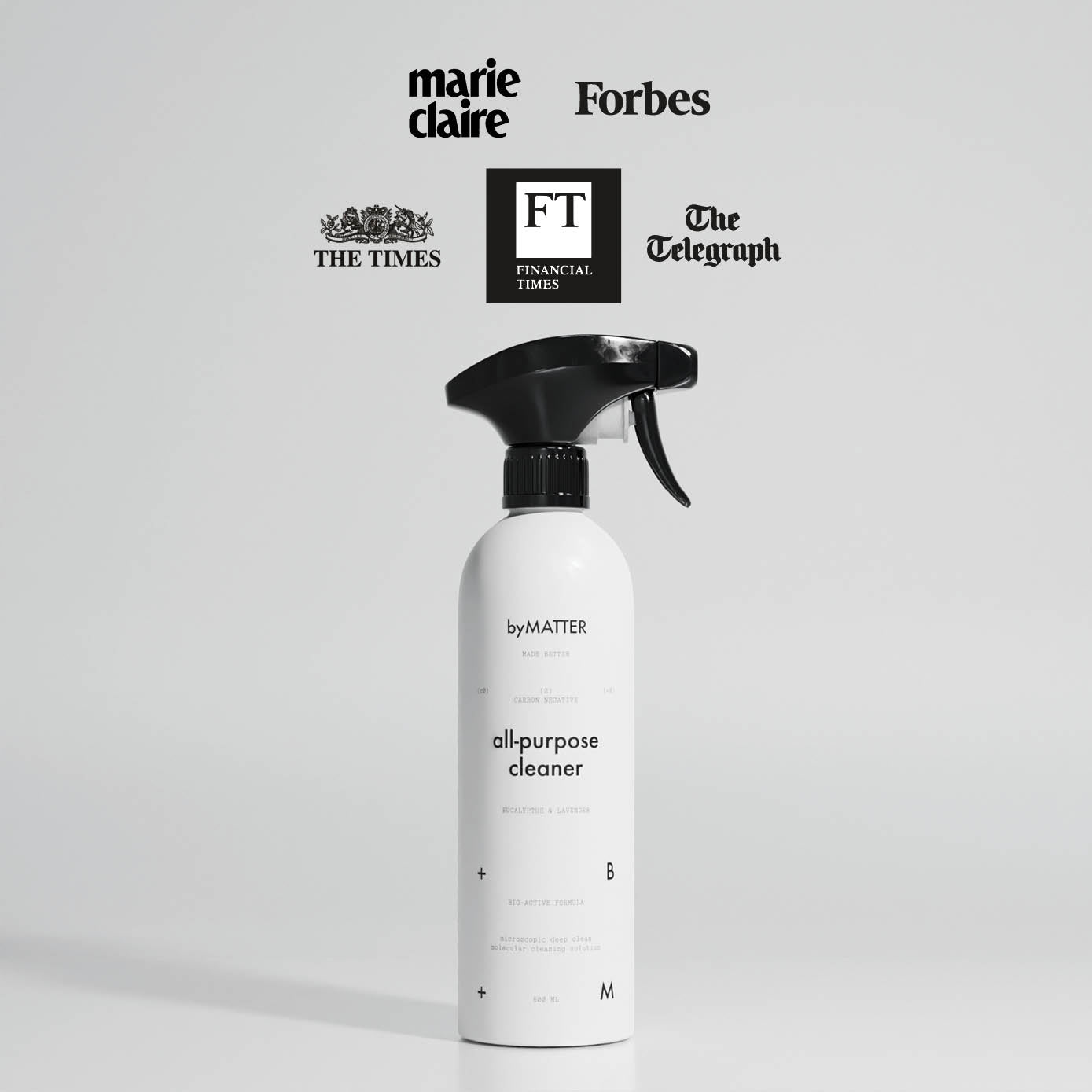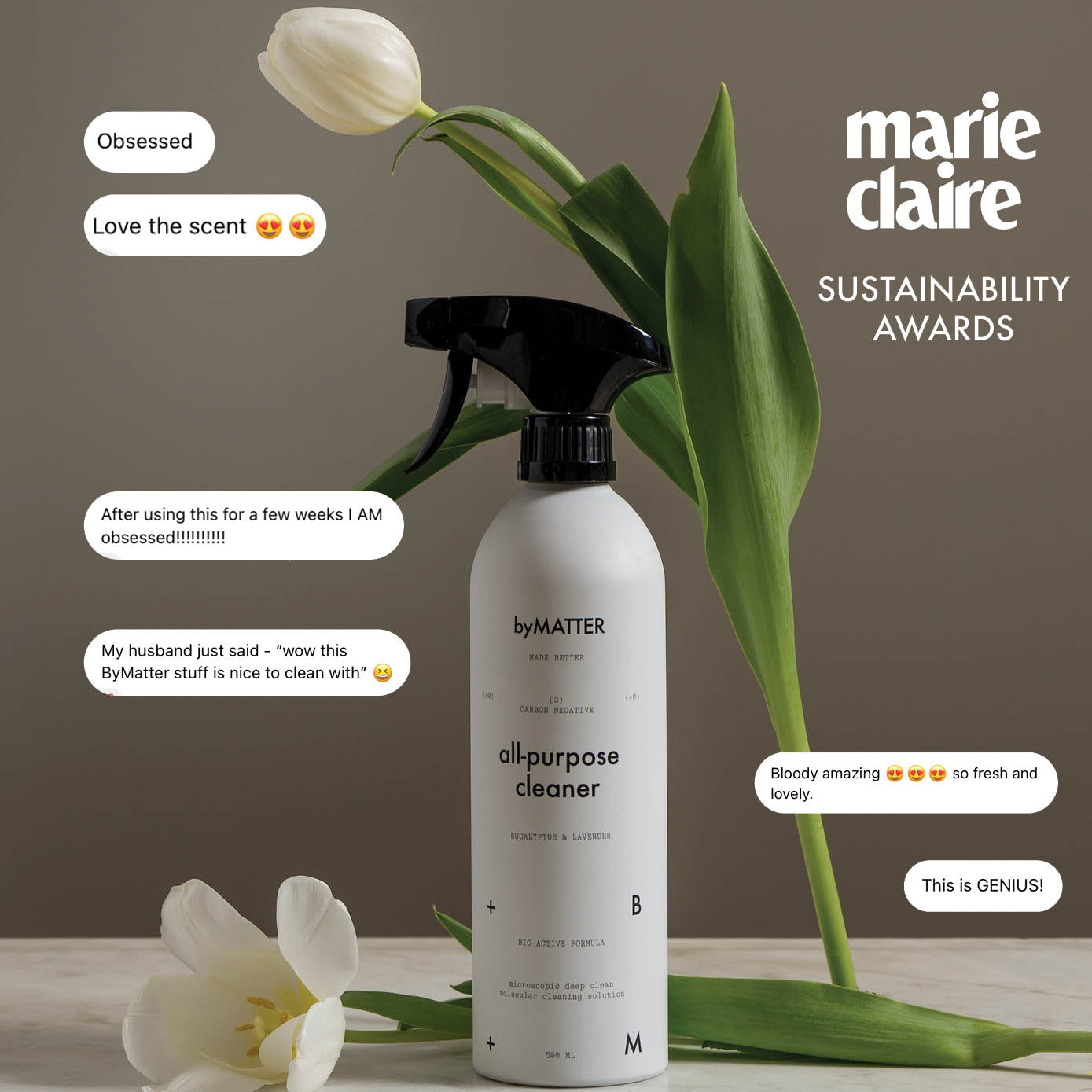the new frontier of laundry
throughout history, improvements in laundry protocols meant improvements in society, life expectancy and household productivity.
however, technologies used in today’s laundry protocols remain broadly stagnant and are based on petrochemical based formulas developed back in the 1920s and 1930s. whilst we see breakthroughs in other areas of biotechnology, laundry formulas and protocols on the market today still include (to various degrees) toxic ingredients that are harmful to both people and the environment. the current landscape is also tainted by significant over-washing which leads to serious consequences on both people and the environment.
this analysis provides an account of new bio-active fabric freshening protocols. we discuss the reasons why this innovative freshening practice is fast becoming the new frontier of the laundry industry. this modern biotechnology outcompetes, controls and neutralises odour-causing bacteria for longer periods of time compared to other fabric fresheners.
we analyse the results which prove that bio-active laundry protocols, by fostering competitive exclusion of odour-causing bacteria, are far more effective than incumbent fresheners on the market today.
this analysis concludes with reporting various well-being benefits that households can derive from regularly using bio-active fabric freshening methods, in particular reduce overwashing, increase household productivity, reduce indoor air pollution, reduce dependence on petrochemicals, reduce textile waste and preserve natural capital.
Copyright © byMATTER MADE BETTER 2023, a trading name of Estra Home London Limited.

history shows laundry protocols matter
many historians have drawn a direct correlation between better laundry protocols, better public health, longer life expectancy and increased household productivity. for example, many historians have linked the removal of the soap tax in Britain in 1853 and the launch of Sunlight Soap in 1884 to being conducive to the Victorian era demographic, productivity and economic boom that followed.
whilst we see breakthroughs in other areas of biotechnology (such as mRNA technology, CRISPR based treatments and better understanding of protein structures thanks to AI), laundry formulas and protocols on the market today contain technology that has broadly remained stagnant for 100+ years and still include (to various degrees) toxic ingredients that are harmful to both people and the environment.
besides, our societies face new challenges such as new harmful bacteria, indoor air pollution and rampant anti-microbial resistance especially in the developing world. new laundry technology, protocols and products are needed.
current laundry protocols trap and consume a lot of resources
studies show the average household spends around 8 hours a month doing laundry, one full working day. and yet 90% of clothes washed aren’t dirty enough to be thrown in the laundry basket. furthermore, every wash cycle consumes up to 200 litres of fresh water, and research shows that excessive washing leads to faded colours, shrinkages, misshaping which are all connected to around 70% of textile waste. with each wash, synthetic fabrics shed thousands of plastic particles, leading to broad-scale contamination of waterways and ecosystems. In summary, we are over washing our way to extinction.
in order to increase household productivity and preserve our environment, we need solutions that enable regular re-wearing of clothes. freshening fabrics and clothes is a simple yet powerful solution and leads to saving time, preserving water and fabrics as well as reducing textile waste.
however, traditional fabric fresheners present two main issues. the first issue is that even those fabric fresheners that contain disinfectants that claim to kill 99.9% of bacteria are effective only for a limited amount of time. research shows that odour-causing bacteria reproduce very quickly. most odour-causing bacteria double in number every half-hour or so. this exponential reproduction curve makes harsh chemicals effective only for a limited period of time. for example, if after spraying harsh chemicals on fabrics only 0.01% of odour-causing bacteria are left, in just a few hours odour-causing bacteria are back in exponentially large numbers.
the second issue with traditional fabric fresheners is their side effects on our body and environment. the ingredients of fresheners typically contain chemicals such as acetaldehyde, propylene glycol and methyl pyrrolidone ethyl acetate, which have been linked to neurotoxicity, skin and eye irritation, allergies and asthma. studies also show that harsh chemicals found in petrochemical based fabric fresheners are a major cause of indoor air pollution. this may be a reason for studies showing that indoor air pollution is up to 5x worse than outdoor air pollution. lastly, these harsh chemicals are also known to be dangerous to aquatic life and other parts of the ecosystem.
new technologies to the rescue
our research focused on new biotechnological solutions that target odour-causing bacteria at a molecular level, instead of just covering them up with fragrances and chemicals.
active probiotics are the future of laundry
probiotics are not new to the laundry care industry. researchers started studying probiotics in the context of laundry care and cleaning in the 1970s, and there has since accumulated a significant amount of scientific studies proving that the use of probiotics is a longer lasting, and more efficacious way to neutralise odour-causing bacteria. scientists have shown that good bacteria work to outcompete and digest odour-causing bacteria, providing a deeper clean on fabrics and clothes.
historically the issue has been to keep probiotics alive for long enough for them to become effective. a recent biotechnology breakthrough has enabled a functionality that keeps probiotics dormant in the bottle. this breakthrough technology means that probiotics are only activated once they are sprayed and come into contact with the fabric surface.
how does a bio-active fabric freshener work?
once sprayed on the surface of the fabric, the bio-active solution (made of plant-based surfactants and active probiotics) activates and works to outcompete and neutralize odour-causing bacteria and dirt.
probiotics multiply very rapidly and penetrate within the fibers of the fabric, even in places traditional harsh chemicals would not be able to reach. competition immediately develops between the good bacteria (probiotics) and odour-causing bacteria. when applied in enough quantities, probiotics are proven to outcompete and neutralise odour-causing bacteria for up to a few days.
notable scientific studies
probiotic-based fabric fresheners significantly reduce the presence of odour-causing bacteria on fabrics, and support the concept of a natural solution that controls the microbial load levels without the need for harsh chemicals.
studies show that probiotic-based solutions, when used in enough quantities, led to a significant reduction (80% and above) of odour-causing bacteria (such as escherichia coli, staphylococcus aureus and candida albicans). in contrast to the bacterial reaction to traditional chemical-based disinfectants, the bio-active solutions are effective in reducing odour-causing bacteria for many days after use. most studies confirm that probiotics neutralise odour-causing bacteria for up to 3 days.
studies show that probiotics were also much safer compared to other fabric fresheners because they are free from harsh chemicals and preservatives found in common home care products.
benefits for households
households can derive various well-being benefits from regularly using bio-active fabric freshening protocols. by introducing this bio-active fabric freshener in their laundry protocol, households can re-gain 4h of time per month (around half a working day) and reduce over-washing by 50%. additionally, using this bio-active fabric freshener as part of their laundry protocol, households can limit their dependence on petrochemical based laundry formulas and reduce indoor air pollution.
frequent use of this bio-active fabric freshener also reduces textile waste. research shows 70% of textile waste is linked to overwashing. studies show that excessive washing leads to faded colours, shrinkages, misshaping and ultimately early disposals of garments. re-freshing and re-wearing clothes is the best way to reduce textile waste.
additionally, with each wash, synthetic fabrics shed thousands of plastic particles, leading to broad-scale contamination of waterways and ecosystems. introducing this bio-active fabric freshener into laundry protocols leads to the preservation of water and our natural capital.
Copyright © byMATTER MADE BETTER 2023, a trading name of Estra Home London Limited.
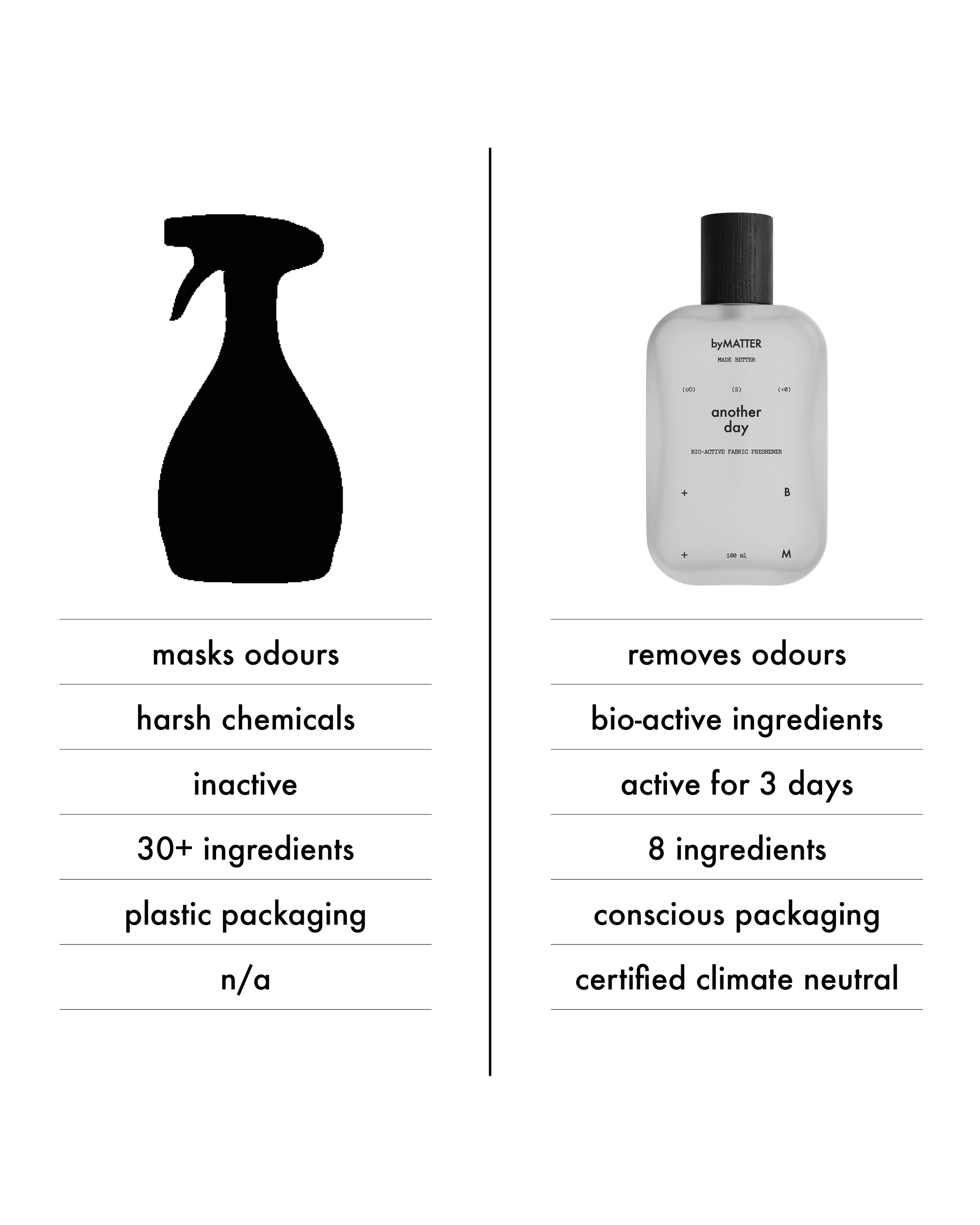
throughout history, improvements in laundry practices resulted in higher standards of living, longer life expectancy and greater household productivity.
however, technologies used in today’s laundry protocols remained broadly stagnant and are based on petrochemical based formulas developed back in the 1920s and 1930s. whilst we see breakthroughs in other areas of biotechnology, laundry formulas and protocols on the market today still include (to various degrees) toxic ingredients that are harmful to both people and the environment.
additionally, there is abundant research to suggest that developed societies are grossly over-washing, resulting in a lower household productivity, adverse health effects, depletion of natural capital and unsustainable textile waste. these issues can be greatly reduced thanks to new fabric freshening biotechnologies that enable increased re-wearing of fabrics and clothes.
this analysis provides an account of new bio-active fabric freshening protocols. we discuss the reasons why this innovative freshening practice is fast becoming the new frontier of the laundry industry. this modern biotechnology outcompetes, controls and neutralises odour-causing bacteria for longer periods of time compared to other fabric fresheners.
we analyse the results which prove that bio-active laundry protocols, by fostering competitive exclusion of odour-causing bacteria, are far more effective than incumbent fresheners on the market today.
this analysis concludes with reporting various well-being benefits that households can derive from regularly using bio-active fabric freshening methods, in particular reduce overwashing, increase household productivity, reduce indoor air pollution, reduce dependence on petrochemicals, reduce textile waste and preservation of natural capital.
Copyright © byMATTER MADE BETTER 2023, a trading name of Estra Home London Limited.
the lancet (2022), global burden of bacterial antimicrobial resistance in 2019: a systematic analysis
the world health organisation (2022), health-care associated infection fact sheet
the economist (2022), Battling the superbugs: drug-resistant infections kill almost 1.3m people a year
neda et al (2021), quantification and exposure assessment of microplastics in australian indoor house dust
bhat et al (2021), environmental and health impacts of spraying COVID-19 disinfectants with associated challenges
scott et al (2020), a 21st century view of infection control in everyday settings: moving from the germ theory of disease to the microbial theory of health
celik et al (2020), biosurfactants’ potential role in combating COVID-19 and similar future microbial threats
stone et al (2020), disinfectant, soap or probiotic cleaning? surface microbiome diversity and biofilm competitive exclusion
velazquez et al (2019), from one species to another: a review on the interaction between chemistry and microbiology in relation to cleaning in the built environment
caselli et al (2018), reducing healthcare-associated infections incidence by a probiotic-based sanitation system: a multicentre, prospective, intervention study
brooks et al (2017), fashion, sustainability, and the anthropocene
robinson et al (2016), literature review of evidence on cleaning products and occupational risks for asthma
vandini et al (2014), hard surface biocontrol in hospitals using microbial-based cleaning products
sekaran et al (2013), integrated bacillus sp. immobilized cell reactor and synechocystis sp. algal reactor for the treatment of tannery wastewater
mccleary (2014), a not-so-beautiful campaign: a feminist analysis of the dove campaign for real beauty
singh et al (2014), microorganism as a tool of bioremediation technology for cleaning the environment: a review.
hixson et al (2010), biological sciences division sesearch highlights, U.S. department of energy.
spök and klade (2009), environmental, health and legal aspects of cleaners containing living microbes as active ingredients
falagas and makris (2007), probiotic bacteria and biosurfactants for nosocomial infection control: a hypothesis
ravi et al (2007), screening and evaluation of probiotics as a biocontrol agent against pathogenic vibrios in marine aquaculture.
tichnor (2006), suds and selfhood: marketing the modern woman in the 1920's, 1930's and 1940's
samet and spengler (2003), indoor environments and health: moving into the 21st century
klepeis et al (2001), the national human activity pattern survey (nhaps): a resource for assessing exposure to environmental pollutants
priest (1977), extracellular enzyme synthesis in the genus bacillus.
by fostering competitive exclusion, odour-causing bacteria are neutralised on the surface of fabrics.

the new frontier of surface cleaning
this analysis provides an account of bio-active surface cleaning protocols.
we discuss the reasons why this innovative surface cleaning protocol is fast becoming the new frontier of the surface cleaning industry. this modern biotechnology outcompetes, controls and tackles harmful bacteria (including certain superbugs) for longer periods of time, when compared to other surface cleaning protocols.
we report studies that compare the efficacy of bio-active cleaning protocols with other cleaning protocols, in particular with disinfectant based cleaning protocols. we analyse various results which prove that, for normal day-to-day activities, bio-active surface cleaning protocols are more effective than disinfectant based cleaning protocols, because bio-active cleaning fosters competitive exclusion of pathogenic bacteria.
this analysis concludes with reporting various well-being benefits that households can derive from regularly using bio-active cleaning protocols, in particular a deeper level of surface cleaning and lower levels of indoor air pollution.
Copyright © byMATTER MADE BETTER 2023, a trading name of Estra Home London Limited.

cleaning protocols matter
throughout history, we observe a direct correlation between evolved household cleaning protocols and higher standards of living. better cleaning protocols always led to better public health, longer life expectancy and increased household productivity. for example, the removal of the soap tax in Britain in 1853 was conducive to the Victorian era demographic, productivity and economic boom that followed.
despite significant innovation in other fields, when it comes to surface cleaning, our societies face new challenges (such as new harmful bacteria and anti-microbial resistance). these new challenges are still addressed using outdated and often counterproductive tools. it is particularly important for our societies to evolve cleaning protocols and introduce new bio-technologies that can better address the challenges we face today.
why are our tools outdated?
bacteria, like all living organisms, reproduce and evolve. what makes bacteria special is the speed of reproduction and mutation. bacteria are among the fastest reproducing organisms in the world, doubling every 4 to 20 minutes. this incredible speed of reproduction is a particular challenge for the surface cleaning industry, especially for disinfectant based cleaning protocols (even those that claim to kill 99.9% of bacteria). bacteria have such a high speed of reproduction that surfaces are re-colonised very quickly. scientific studies show how a sanitized surface is again populated with harmful bacteria in just a matter of hours. the new frontier of household surface cleaning is using probiotics to outcompete harmful bacteria and inhibit their reproduction.
an additional challenge with bacteria is that they evolve and mutate, sometimes in more harmful strains. certain strains of bacteria have mutated so much that they are now immune to antibiotics, harsh chemicals and disinfectants. these are called superbugs. for example, st131-h30r, a strain of escherichia coli, mutated to become resistant to multiple antibiotics. this phenomenon is generally referred to as antimicrobial resistance (AMR) and is very concerning. the World Health Organization and other public health institutions including the UK government identified AMR as one of the greatest threats of our time.
AMR is present especially where surfaces are cleaned very regularly with disinfectant-based cleaning protocols. for example, studies show hospital surfaces are becoming a pathogen reservoir given the heavy traffic of pathogen-laden patients, the regular sterilization of surfaces and the liberal use of antibiotics. this is why healthcare-associated infections are becoming a global concern. latest estimates from the WHO report that, even in developed countries, between 7% and 10% of hospitalized patients acquire at least one infection whilst in hospital.
the new frontier of surface cleaning
latest studies show that probiotic cleaning protocols are the new frontier of surface cleaning. probiotics are not new to the cleaning industry. researchers started studying probiotics in the context of surface cleaning in the 1970s. since then we have accumulated a significant amount of scientific studies showing that probiotics based cleaning protocols outcompete, control and neutralize harmful bacteria more effectively and for longer periods of time (when compared to disinfectant based protocols). scientific studies show that bio-active cleaning protocols are effective even against bacteria that developed superbugs or antimicrobial resistant strains, for example escherichia coli, staphylococcus aureus and pseudomonas aeruginosa.
how bio-active cleaning protocols work?
once sprayed on the surface, the probiotics activate and work to outcompete and tackle harmful bacteria and dirt. probiotics multiply very rapidly and penetrate deep into surfaces, even in places disinfectants would not be able to reach. competition immediately develops between the good bacteria (probiotics) and harmful bacteria. when applied regularly and in enough quantities, probiotics are proven to outcompete and tackle harmful bacteria (including certain superbugs).
in bio-active cleaning processes, the active agent is a microorganism of a similar make-up to the microorganisms found on surfaces and not a harsh chemical compound of a foreign make-up to the microorganisms found on surfaces.
two studies were selected from the scientific literature:
study one:
four different cleaning protocols were carried out for eight-months on three common types of surfaces (linoleum, ceramic and stainless steel). the study focused on the effect these four cleaning protocols (disinfectant, plain soap, a probiotic-based cleaner, and tap water) have on the resident microbiome. harmful bacteria and pathogens (such as escherichia coli and staphylococcus aureus) were deposited and desiccated. competitive exclusion was assessed for each type of surface.
the study showed that probiotic cleaning protocols fostered competitive exclusion far more effectively than disinfectants and tap water cleaning protocols. the research showed that disinfectant cleaning protocols actually promote the survival of deposited pathogens in the resident microbiome. probiotic cleaning protocols instead limit harmful bacteria due to higher efficacy in forming stable surface bio-films.
the study suggests that the bio-active surface cleaning protocol proved to be the best protocol to control the spread of harmful bacteria. it highlights major benefits from shifting away from solely relying on disinfectants for household surface cleaning routines.
study two:
this study compares bio-active cleaning protocols with disinfectant based cleaning protocols. tests were carried out for 24 weeks in 3 European hospitals. approximately 20,000 microbial surface samples were collected and analysed. samples were collected 3-6 hours after cleaning from a broad range of surfaces such as floors, doors, showers and toilets.
the study concluded that probiotic cleaning protocols consistently reduced harmful pathogens on surfaces by up to 89%. as discussed above, whilst some disinfectants may eliminate 99.9% of all microbial life for a brief period, the speed at which bacteria grow back makes the disinfectant based cleaning protocol effective just for a short period of time.
instead, probiotic-based cleaning protocols work to reduce harmful bacteria load on surfaces for long periods of time and create a much healthier living environment.
where should disinfectants feature?
the new frontier of household surface cleaning is predominantly made of bio-active cleaning protocols but there is certainly still space for a selective use of disinfectants based cleaning protocols. the use of disinfectants should be limited to areas with an extremely high concentration of pathogens, and only those disinfectants proven not to contribute to AMR should be used. however, frequent and copious use of disinfectants based cleaning protocols for household cleaning routines is discouraged for two reasons. first, because of the limited efficacy (as discussed above). second, because of the proven side effects on both people (asthma, hormone disruption and lung irritation) and the environment (contamination of water and soils).
disinfectants also contribute to indoor air pollution
indoor air pollution is shown to be up to 5x higher than outdoor air pollution. multiple studies show how everyday cleaning activities influence the quality of indoor air, with cleaning products showing to be a leading cause of indoor air pollution. according to environmental experts the average household contains about 62 toxic chemicals, more than most chemistry labs. this is largely a result of the harsh chemicals found in household cleaning products. these chemicals are released into the air when we spray cleaning products, contributing to the escalating problem of indoor air pollution. investigations in nurseries also found that in the 310 nurseries analysed, 152 harmful or irritants substances were identified.
production of bio-active and disinfectants cleaning formulas
probiotic-based formulas not only benefit the indoor environment but also the surrounding ecology. for years probiotics have been used in the bio-remediation of ecosystems, successfully working to clean up contaminated soil, air and water. these microorganisms are stimulated to rapidly degrade hazardous organic matter such as soils, sediments and water. probiotics break down long chain molecules in chemical additives in hydrocarbons, which leads to the natural bio-degradation of the hydrocarbons themselves.
the production of disinfectant cleaning products is instead a cause of environmental concern. many disinfectants originate from petrochemical compounds that contribute to the climate crisis across the various phases of their lifecycle. the production process of disinfectants causes serious side effects to local societies and often contaminates ecosystems. both direct and indirect sewage effluents from disinfectant-producing plants end up in lakes and rivers, posing a threat to aquatic ecosystems and wildlife.
Copyright © byMATTER MADE BETTER 2023, a trading name of Estra Home London Limited.
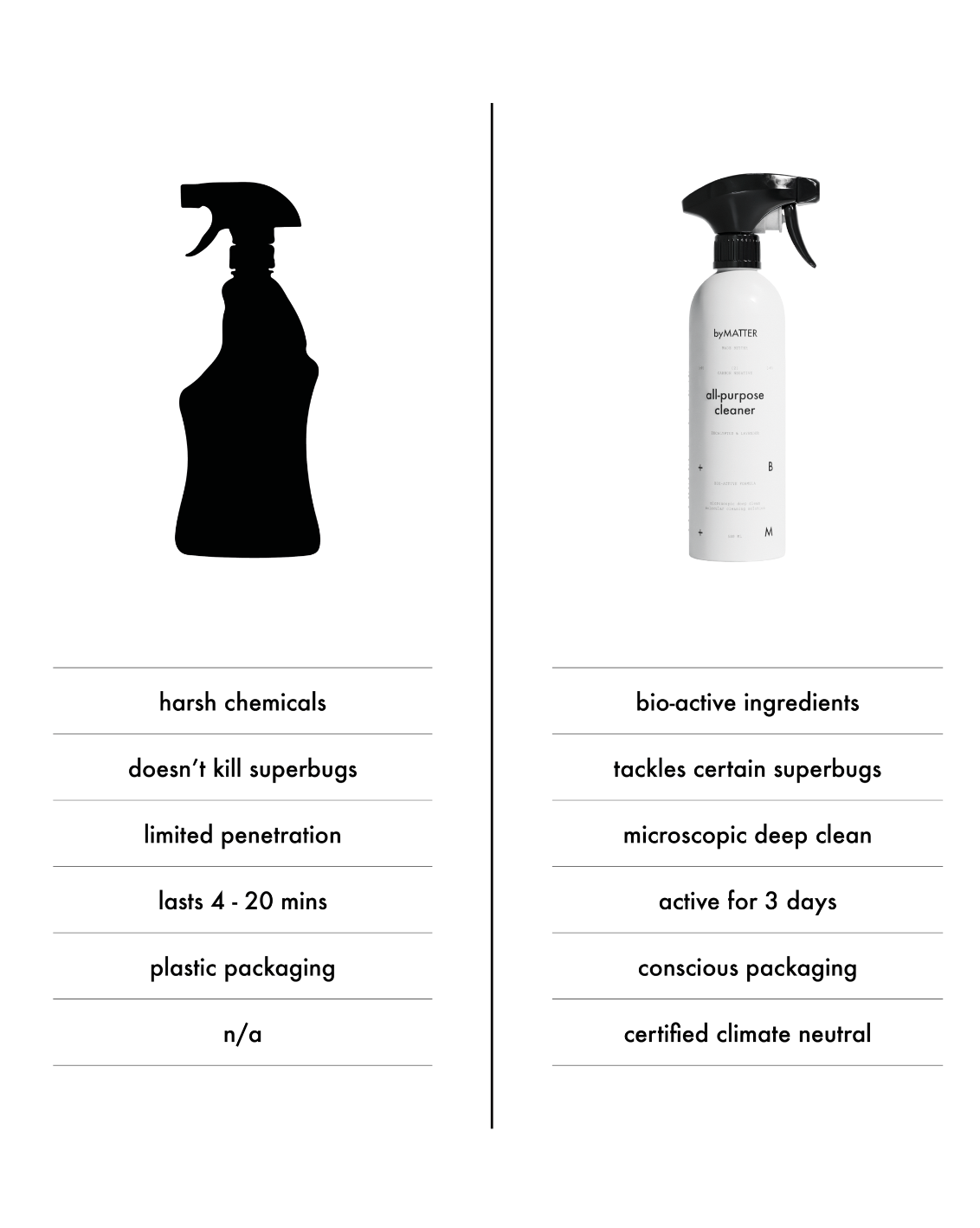
research shows bacteria are among the fastest reproducing organisms in the world, doubling every 4 to 20 minutes. this exponential speed of reproduction is a particular challenge for the surface cleaning industry.
this analysis compared bio-active surface cleaning protocols with disinfectant-based cleaning protocols. bio-active cleaning solutions are more effective at outcompeting, controlling and tackling harmful bacteria (including certain superbugs), when compared to other surface cleaning protocols.
from the scientific literature two studies were reported and analysed. both studies show that bio-active surface cleaning protocols, by fostering competitive exclusion of pathogenic bacteria, are more effective in tackling and controlling harmful bacteria load on surfaces for longer periods of time.
this analysis concludes with reporting various benefits that households can derive from regularly using bio-active cleaning protocols, in particular a deeper level of surface cleaning and lower levels of indoor air pollution.
whilst further research is welcomed, bio-active formulas are already proven to be a more effective and sustainable alternative to disinfectant based formulas currently on the market.
bio-active cleaning is fast becoming the new frontier of the surface cleaning industry.
Copyright © byMATTER MADE BETTER 2023, a trading name of Estra Home London Limited.
the lancet (2022), global burden of bacterial antimicrobial resistance in 2019: a systematic analysis
the world health organization (2022), health-care associated infection fact sheet
financial times (2022), it’s time to confront the pandemic of antibiotic resistance
the economist (2022), battling the superbugs: drug-resistant infections kill almost 1.3m people a year
financial times (2022), antibiotic resistance kills over 1m people a year, says study
neda et al (2021), quantification and exposure assessment of microplastics in australian indoor house dust
bhat et al (2021), environmental and health impacts of spraying covid-19 disinfectants with associated challenges
los alamos national laboratory (2020), squashing superbugs: some bacteria are resistant to disinfectants but not for much longer
scott et al (2020), a 21st century view of infection control in everyday settings: moving from the germ theory of disease to the microbial theory of health
celik et al (2020), biosurfactants’ potential role in combating covid-19 and similar future microbial threats
stone et al (2020), disinfectant, soap or probiotic cleaning? surface microbiome diversity and biofilm competitive exclusion
tchesnokova (2019), pandemic uropathogenic fluoroquinolone-resistant escherichia coli have enhanced ability to persist in the gut and cause bacteriuria in healthy women
velazquez et al (2019), from one species to another: a review on the interaction between chemistry and microbiology in relation to cleaning in the built environment
caselli et al (2018), reducing healthcare-associated infections incidence by a probiotic-based sanitation system: a multicentre, prospective, intervention study
brooks et al (2017), fashion, sustainability, and the anthropocene
robinson et al (2016), literature review of evidence on cleaning products and occupational risks for asthma
vandini et al (2014), hard surface biocontrol in hospitals using microbial-based cleaning products
sekaran et al (2013), integrated bacillus sp. immobilized cell reactor and synechocystis sp. algal reactor for the treatment of tannery wastewater
mccleary (2014), a not-so-beautiful campaign: a feminist analysis of the dove campaign for real beauty
singh et al (2014), microorganism as a tool of bioremediation technology for cleaning the environment: a review.
hixson et al (2010), biological sciences division sesearch highlights, U.S. department of energy.
spök and klade (2009), environmental, health and legal aspects of cleaners containing living microbes as active ingredients
falagas and makris (2007), probiotic bacteria and biosurfactants for nosocomial infection control: a hypothesis
ravi et al (2007), screening and evaluation of probiotics as a biocontrol agent against pathogenic vibrios in marine aquaculture.
tichnor (2006), suds and selfhood: marketing the modern woman in the 1920's, 1930's and 1940's
samet and spengler (2003), indoor environments and health: moving into the 21st century
klepeis et al (2001), the national human activity pattern survey (nhaps): a resource for assessing exposure to environmental pollutants
priest (1977), extracellular enzyme synthesis in the genus bacillus.

BIOREMEDIATION OF ECOSYSTEMS
probiotics have been successfully used to clean up contaminated soil, air and water for years.
these microorganisms are stimulated to rapidly degrade hazardous organic matter such as soils, sediments and water. they break down long chain molecules in chemical additives in hydrocarbons, which leads to the natural bio-degradation of the hydrocarbons themselves.

REDUCE INDOOR AIR POLLUTION
byMATTER formulas are free from phosphates, bleaches, chlorines, phthalates, toluene, formaldehydes, colourants and quats.
swapping to byMATTER cleaning formulas reduces the volatile organic compounds (VOC's) emitted in the indoor environment, which in turn reduces indoor air pollution caused by exposure to chemicals.

PREVENT BACTERIAL RESISTANCE (AMR)
probiotic-based cleaning protocols work to reduce harmful bacteria, and thus prevent antimicrobial resistance (AMR).
byMATTER formulas include active probiotics that are non-mutative and restore microbial balance. The bio-active formulas also support allergy management as the active probiotics target allergy-triggering matter such as pollen and mould.

PROMOTE A BALANCED MICROBIOME
the microbiome plays a crucial role in physical and mental health. not only does it protect against pathogens, it also trains the immune system, instructs the metabolism and helps program the brain. the right balance of bacteria is essential to maintain wellness, hygiene and prevents disease spread.
probiotics naturally restore healthy bacterial balance, and foster balanced microbiomes that support well-being and immunity.
Copyright © byMATTER MADE BETTER 2023, a trading name of Estra Home London Limited.
probiotic cleaning reduces the growth of pathogens and continues to work for days after application





